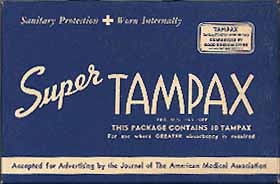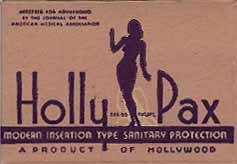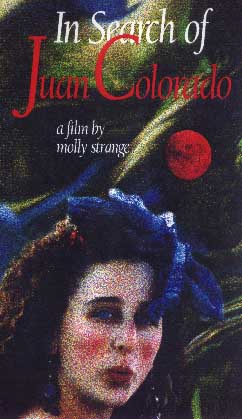In 1995, a woman who read an article about
this museum in the Chicago Tribune newspaper
donated boxes of fax,
Fibs, and other tampons and advertising
material from the 1930s left by her father,
who had worked for Kotex.
In 2001, Procter
& Gamble, owner of Tampax and
Always pads, donated scores of boxes of
tampons and other menstrual products from
the 1930s to the 1960s.
And, of course, the first Tampax AND -
special for you! - the American fax
tampon, from the early 1930s, which also
came in bags.
See a Modess True
or False? ad in The American Girl
magazine, January 1947, and actress Carol Lynley in
"How Shall I Tell My Daughter" booklet ad
(1955) - Modess . . .
. because ads (many dates).


|

Tambrands Gives Your MUM
an Extraordinary
Collection
 Last week, the
maker of the best-selling tampon
in the world, Tambrands, which
makes Tampax, sent this museum
almost 150
boxes of tampons from around the
world, 20 old booklets from
various companies explaining
menstruation and women's health
to girls, and hundreds of pages
of advertising created decades
ago by Tampax and other
companies. (Tambrands sent MUM another 300
boxes and other material a few weeks
later.) Last week, the
maker of the best-selling tampon
in the world, Tambrands, which
makes Tampax, sent this museum
almost 150
boxes of tampons from around the
world, 20 old booklets from
various companies explaining
menstruation and women's health
to girls, and hundreds of pages
of advertising created decades
ago by Tampax and other
companies. (Tambrands sent MUM another 300
boxes and other material a few weeks
later.)
As you may know, Procter &
Gamble, maker of the best-selling
menstrual pad Always, bought
Tambrands, and is moving the
Tambrands research facility to
Cincinnati, Ohio. Company
officials couldn't take everything
with them, so duplicates of
product samples and advertising
were offered to MUM by the
Research Library. (Procter &
Gamble generously donated
many items to this museum from its
own archives in 2001.)
This is a
fantastic and generous gift!
With this donation this museum
increases tenfold its holdings of
information about the menstrual
cups Tassette
and Tassaway,
and now owns many more documents
about products long dead. Anyone
ever hear of Kotams,
Colleens,
Slim-pax,
Nunap,
Nappons,
or the Anna
Health Sponge?
 MUM
now has boxes, including tampons,
of the Tampax
produced in 1939 (shown
above), three years after the
company started selling the first
applicator tampon in the world.
And Tambrands sent MUM boxes of Holly-Pax
(at left), a tampon made in
Hollywood, and product displays
for the Wix tampon (see the Wix folder
MUM just received). Tampax
absorbed, so to speak, both
companies in the 1930s. (Both
Tampax and Holly-Pax claim on the
boxes that they were accepted for
advertising by the Journal of the
American Medical Association. They
were, but the statement got Tampax
in hot water with JAMA, according
to the Tampax company history, Small Wonder.
It seemed to imply endorsement of
that then still controversial
item, Tampax.) MUM
now has boxes, including tampons,
of the Tampax
produced in 1939 (shown
above), three years after the
company started selling the first
applicator tampon in the world.
And Tambrands sent MUM boxes of Holly-Pax
(at left), a tampon made in
Hollywood, and product displays
for the Wix tampon (see the Wix folder
MUM just received). Tampax
absorbed, so to speak, both
companies in the 1930s. (Both
Tampax and Holly-Pax claim on the
boxes that they were accepted for
advertising by the Journal of the
American Medical Association. They
were, but the statement got Tampax
in hot water with JAMA, according
to the Tampax company history, Small Wonder.
It seemed to imply endorsement of
that then still controversial
item, Tampax.)
One piece
of paper rattles my cherished
belief about what the first
commercial tampon was, and adds
more interest to the challenge
MUM makes to you, the sleuths who
will solve this problem for
riches and honor (see the contest conditions)! Get busy!
Menstrual hygiene products and
documents, with toilet paper, make
us understand what the word
ephemera means. That's why this
gift is so important.
People around the world have
donated thousands of items to this
museum. Outside of the archives of
the various companies involved in
menstrual hygiene, I doubt that
there is a greater collection of
items relating to menstruation in
the world. (A staff member of the
Smithsonian Institution has twice
asked for this museum.) Part of it
is on display. My dream is that
the public can see much more of it
in its own building in the future,
as part of the extraordinary
history of women's health. You
deserve it.
I hope to get a grant to
archivally preserve the Tampax
gift and that part of the MUM
collection not already so treated.
The museum has thousands of pages
of print advertising from around
the world; copies of television
advertising and educational films
for schools; thousands of boxes
and samples of napkins, tampons,
sponges, cups and underwear;
articles and patents; and other
items.
By the way, Patricia Hart,
the administrator of the Research
Library at Tambrands, writes that
Procter & Gamble "has done an
outstanding job handling the
people [at Tambrands] during this
difficult time, and I'm sure
they'll also do an outstanding job
growing the Tampax brand."
Disgusting!
A visitor in England to this Web
site found MUM through a link on a
homepage in Sweden. Impressed with
the page owner's good taste, I
asked the Englishman for the
address of the site. He wrote back
that
she [the
Swedish creator of the
homepage] told me that she had
only included the link because
she thought the idea of the
museum was so "disgusting" - her word -
and didn't think that I should
have any interest in such
matters.
Not everyone fits the popular
idea of Swedish broad mindedness!
Recently another Swedish woman -
hmm, or
was it the same person?
- e-mailed me that her dog's name
was Mum, and asked if I was a dog.
I said no, but that I had a cat
named Mack
C. Padd (a nephew's
girlfriend named him and gave him
to me), and, showing off, asked in
my best Swedish why she named her
dog Mum.
No reply as yet. Maybe my
Swedish was just not good enough.
A
Film About That First Time
Molly Strange, a writer and
filmmaker in California, has
filmed an unusual and
interesting story about a girl's
first period. It's designed
mainly for girls ages 9-18, boys
10-18, but also for a general
audience. She writes,
 In Search of
Juan Colorado is the
lively and humorous story of a
tomboy's journey toward her first
period and how, with the help of
her friends Ruth and Lily, she
turns this dreaded event into a
positive experience. In Search of
Juan Colorado is the
lively and humorous story of a
tomboy's journey toward her first
period and how, with the help of
her friends Ruth and Lily, she
turns this dreaded event into a
positive experience.
Twelve-year-old Marty Thayer is
a dedicated tomboy. When she
sneaks out of her house with her
friends on an adventure to look
for a hermit who supposedly lives
in the nearby woods, Marty learns
about anger, betrayal, friendship,
and ultimately, her period.
In Search
of Juan Colorado provides
diversity in role models for
children by portraying three
different characters struggling to
define themselves in relation to
societal pressures. This film
shows the girls' coming to accept
and celebrate this important, yet
virtually ignored, rite of
passage. For boys and men, this
film offers a view onto a usually
secret, silent female event.
The film
works in the classroom as a
companion to a biology-based
film, and can be a touchstone
for discussions of topics listed
above.
Molly continues,
Here's how I came to make this
film.
A number of experiences
coalesced during a short period of
time back in 1990.
I was doing exploratory writing
about tomboys in general and my
experiences as a tomboy. I
recalled a number of experiences
that all revolved around starting
my period, and realized that there
were absolutely no films about
menstruation at all.
One of my favorite films is Stand
By Me. I walked out of the
theater after seeing that for the
first time and realized that there
was not even a single female in
the entire movie. But the
feelings, the themes of growing up
were so important. But if that
film had been made about girls,
what would be important?
I was meeting on a regular basis
with two other filmmakers to talk
about scripts. One day I asked
them about menstruation. One guy,
a Mexican-born filmmaker, told me
his story of growing up with his
mom and two sisters. They spoke
about "Juan Colorado." Francisco
thought this was some mysterious
guy he'd never met - until he was
about 14 and realized that they were
speaking in code about their
period. It turns out this
was a common euphemism from their
region of Mexico. "Juan Colorado"
means "John
Red" - just a code name
for this monthly event. They felt
giving it a man's name made it better, less
detectable.
And those
were the seeds that germinated
into my story of In Search of
Juan Colorado.
I wrote for about six months and
then began raising money. Within
nine months I had about $20,000
and began shooting in March, 1991.
Contact Molly by e-mail.
The 29-minute video is available
directly from her at molly_strange@amat.com Good viewing!
Speaking of Juan Colorado,
Is This the Way Euphemisms Start?
Miki
Walsh, a member
of the board of directors of
this museum, pals around with a
folk group, which recently
invited her to go to the beach
with them. Let's hear Miki tell
it:
I told them I couldn't 'cuz I
was going to the Museum of
Menstruation that day. Then I
explained about MUM a bit. One
of them starts laughing and is
like, "You mean you're REALLY
going to a Museum of
Menstruation?!?! I thought that
you were using a witty euphemism
and saying that you didn't want
to go to the beach 'cuz you had
your period!"
So there you are . . . . MUM
is coined in a term! "Sorry,
honey, I can't go swimming today
. . . I'm going to the Museum of
Menstruation!"
Does Leptin
Trigger Menstruation?
A study published in the October
issue of the Journal of Clinical
Endocrinology and Metabolism
provides support for the
hypothesis of Rose Frisch of
Harvard University, which claims
that women need a certain level of
fat to be able to reproduce.
Researchers at Ohio State
University have found evidence
that leptin, a hormone produced by
fat cells, may trigger the onset
of menstruation, menarche. It
could be that the body only
prepares itself for reproduction
when the woman has sufficient
energy for the job in the form of
fat. This fat level is indicated
by the amount of leptin in the
blood.
It's well known that very thin
women, such as anorectics, or
women with very low body fat
because of exercise, can stop
menstruating.
LAST
CHANCE - This Thursday -
to See the Feminine Hygiene
Comedy Group in New York!
Get all
the facts and/or call the
Fried Eggs Hotline at
212-475-1284*1 for more
information about the
all-feminine crew!
|
NEXT older news
© 1998 Harry Finley. It is
illegal to reproduce or distribute
any of the work on this Web site
in any manner or medium without
written permission of the author.
Please report suspected violations
to hfinley@mum.org
|
|